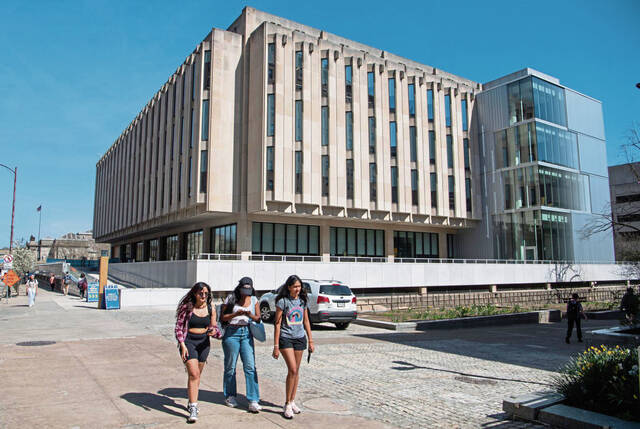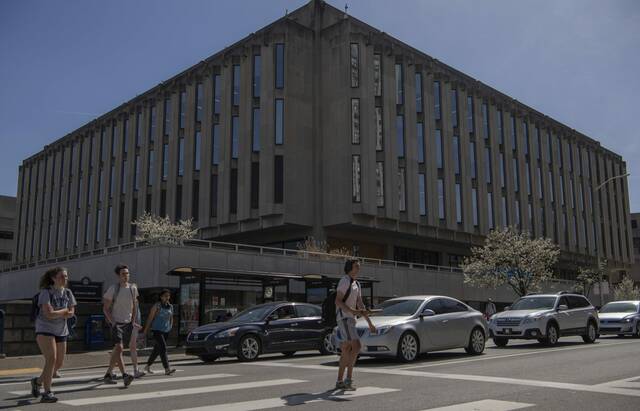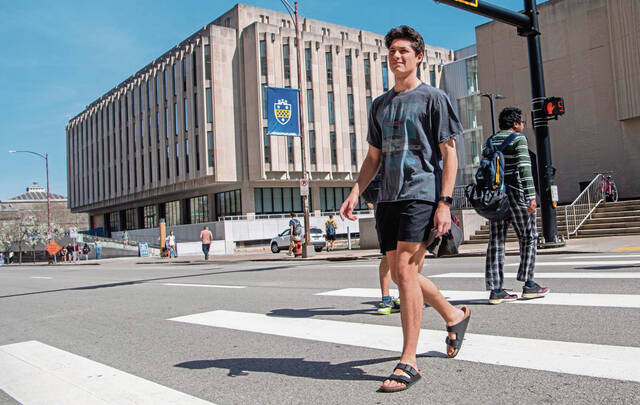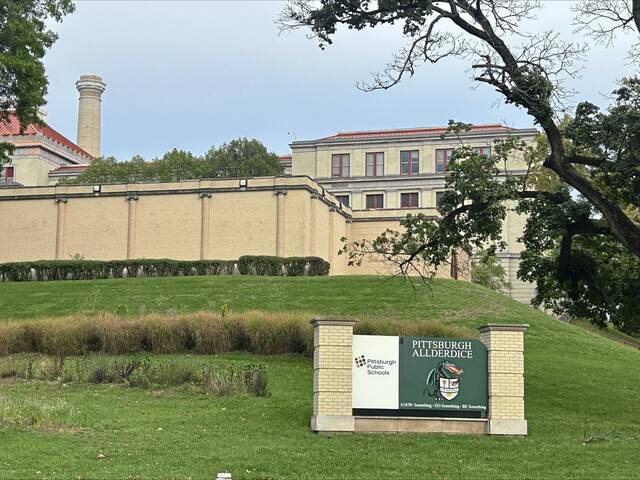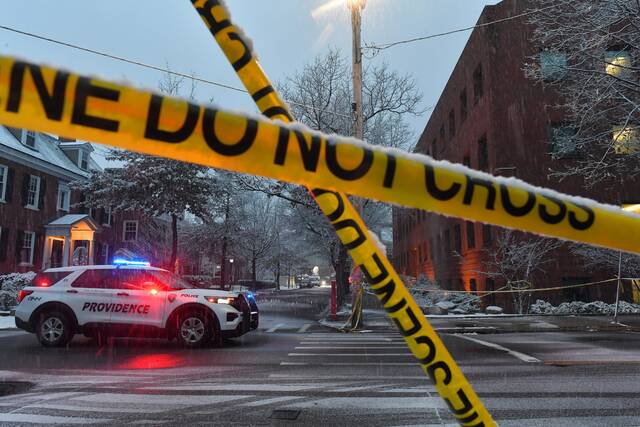Jullian Lorenzo awoke in his dorm room at the University of Pittsburgh late Monday night to the sound of sirens, nonstop coming from outdoors and 10 stories down.
Peering from his window inside Bruce Hall, diagonally across Forbes Avenue from Hillman Library, he saw a chaotic scene, the start of another “swatting” or bogus active shooter call that has spread terror in Oakland in the last couple weeks.
“I counted at least 20 cop cars” and officers carrying long guns and other equipment, said the 18-year-old freshman from Morristown, N.J.
Hundreds of frightened students and others poured from the library complex on a weeknight with finals approaching, as emergency vehicles clogged the main artery, looking for a nonexistent shooter in the library that was reported to city police at 11:10 p.m.
City officers fired perhaps four to six shots to gain entry through a ground-floor door that was locked for renovations, further rattling onlookers, before the building was cleared, campus officials said.
Only it didn’t end there. Just as police reported the all-clear at Hillman, another call to city police sent officers to a nearby campus building, Mervis Hall, after a frightened caller heard noises and thought there might be a threat. It was cleared, too.
But a decision by campus police to hold off sending a campus alert until the Mervis call was deemed no threat drew outrage from some students and parents, who were watching the drama unfold on social media from on and off campus.
A total of 1 hour and 26 minutes elapsed from the initial call at Hillman at 11:10 p.m until 12:36 a.m. when the emergency message went out.
The university and its campus police Chief Jim Loftus said they are retraining individuals and making modifications as a result. Loftus said he was proud of officers’ actions in keeping the public safe but also said the delay in notifying campus was not acceptable.
Campus and city police with help from the FBI, meanwhile, are investigating the source of the calls.
In a note to campus late Tuesday, Pitt Chancellor Patrick Gallagher outlined several moves, including a reassessment of the university’s emergency notification system, saying the response “to a false alarm” about “a potential active killer in Hillman Library on our Pittsburgh campus has caused widespread fear and concern.”
He noted the incident came on the heels of similar threats to Central Catholic and other high schools in and outside the city a couple weeks ago.
“Such events have raised questions about our ability to effectively manage these threats to our safety,” Gallagher wrote. “I agree with these concerns and, because such threats are not going away, we must do better.”
He said that in addition to the actual threat, there is a danger emerging through the intentional use of false information to exploit the response.
“This type of false alarm is sometimes referred to as a ‘hoax,’ ‘swatting’ or ‘prank call,’ but it is, by and large, a terroristic disinformation attack,” he wrote. “It causes real harm, traumatizes victims and requires the rapid mobilization of a full-scale response from law enforcement.
“Unfortunately, it seems that the more these attacks achieve their intended reaction, the more they are likely to recur.”
The Pitt student government board cited concern and disappointment about the university’s response to the hoax shooting call in a statement Tuesday.
“A weapon was discharged by the Pittsburgh Bureau of Police into one of our library’s doors while students were studying — causing panic — yet we received no information from our University,” the statement read. “Instead, many Pitt students, including members of (the student government board), found out about reports of an active shooter from their peers and videos on social media, and not from Pitt officials or the university’s Emergency Notification System.”
The board, which is composed of nine elected positions and 30 appointed ones, called on the university to “take steps to address the failure of the ENS” and advocated for any students who chose to protest against the university because of its response. It also called on the school to do more to support students’ mental health in the wake of the crisis and asked Pitt to apologize.
“There should be no disciplinary action taken towards students who protest in response to this event, and (we) will stand sternly behind all Pitt students and faculty,” the statement said. “Students have a right to feel and be safe on campus, and that includes a knowledge of ongoing threats.”
Pittsburgh police from multiple zones responded to the campus, according to a statement from city police information officer Cara Cruz.
“During the active investigation, a Pittsburgh Police officer utilized a firearm to gain access to a locked door of the Hillman Library to clear the building of any possible threat,” she said.
“There was no evidence of any other shots fired.”
Earlier Tuesday, at a news conference in the Pitt Public Safety Building, Loftus, flanked by FBI special agent Scott Argiro, took questions from reporters and gave the time line of events.
At 11:10 p.m., the first of at least three phone calls was made to city police, not through the 911 center but to a police substation.
“It’s not a recorded line,” Loftus said. “(An officer) is sitting at the front desk. The call basically says there’s a shooter in Hillman.”
“In the background — we don’t know if it’s real or simulated — there was the sound of gunshots on that call.
The caller hung up and at least two more calls came in reporting a shooting on campus, but they ended abruptly, too.
Police working off a joint city-campus radio frequency were dispatched to Hillman at 11:14 p.m. and arrived one minute later.
Loftus said no shooter was found, and officers relayed that the building was clear based on an initial sweep.
Loftus said he and police were preparing to send word to campus through the Emergency Notification System that nothing was found.
But at that point, a call came in from Mervis Hall, where the business school is located, saying footsteps were heard, and that they didn’t seem to be from police.
He said that apparently legitimate call reporting a possible threat changed the dynamic, and he opted to delay sending out a message reflecting the all clear.
“That was my call,” Loftus said. “It would have been, quite frankly, irresponsible to put that message out not knowing what was going on at Mervis.
“Bear in mind, it’s a highly dynamic situation,” he said. Lots of information was coming in, not just from the three phone calls but from other calls as well as social media. “We were being bombarded.”
Officers arrived at Mervis, searched the building and a little after midnight reported that location was clear.
At 12:36 a.m. a notice went to campus.
Loftus said the officers’ number one priority was making sure there was no active threat to students or others on campus.
“My regret and my responsibility is that we didn’t get the emergency notification system message out as quickly as we could have or should have,” he said.
A flawed message without instructions went out a minute before the actual alert but was quickly updated.
Asked about student complaints that some emergency doors on the ground floor and above were locked and chained due to renovation, Loftus said his understanding is they were marked as not to be used in an emergency. He said someone likely assessed the relative risk of sealing those doors against allowing students to flee into a construction area.
Lorenzo, who said he was rousted from sleep by the noise between 11:20 and 11:30 p.m., described a view similar to videos on social media, with people leaping over an outdoor railing and running away from the building.
“It was pretty scary to see all these kids just full-on sprinting to get away,” Lorenzo said. “I think some still had their stuff inside Hillman.”
Two of his three roommates were already up and looking out their windows, trying to process what they saw.
Lorenzo said that from what he heard at the time, and what he saw on social media, some students and parents were furious at the delay in emergency alerts.
“They definitely could have done better,” he said.
At the same time, Lorenzo added, even a timely emergency alert would have been hard-pressed to keep up with images and messages already steaming onto Instagram, Twitter and other platforms that students have on their phones and other devices.
Fortunately, he said, his resident assistant reacted quickly, sending those on his floor messages.
“She texted, ‘Stay inside,’” Lorenzo said.
He texted his parents back in New Jersey and asked his roommates if they were videoing what they saw in order to have proof of what had happened.
“Just in case, God forbid,” he said.
Lorenzo said it would not shock him if at some point the real thing comes to his campus, noting the frequency of shootings throughout the country. “Unfortunately, that’s the life we live,” he said.
Loftus said he understands the terror people faced Monday night, both as a police chief, and a parent whose daughters attend Pitt.
He vowed stepped up patrols. He said it has occurred to law enforcement that through these hoaxes, “We’re being tested.”


